New member here
I've had my Cyclone for many years now, it's been very reliable as it was in very good condition when I bought it, i've done plenty of minor repairs on it over the years, but all cosmetic or mechanical or very basic electronic.
before Xmas I was cleaning the trough under the spook-house and boomerang, there were a couple of flash bulbs out in it too, it still flashed as i can't remember if there are 3 or 4 flash bulbs in there, but at least 1 was still working.
after putting in new bulbs, none of the flash lights in the trough under the spook-house and boomerang flashed any more.
I tried putting the bulbs in that I had taken out and still no flashing. I even swappee around the order of the bulbs several times, Importantly - The carousel stopped spinning at the same time.
I changed the bulbs with the power off so was convinced id not shorted anything.
are the two related in some way ? and what might need replacing to fix it ?
I assumed something on the main board had blown as a result of higher current required to drive all bulbs.
without the carousel working it makes the game fairly pointless to play, even after i blocked the path to the carousel with a sponge, my kids didn't want to play it anymore.
so its probably been powered off now for 3 months and im still being nagged about when im going to fix it.
now when powered up, we have a 3rd problem, one section of each digit on the top row of the display is out, I have examined and tested the displays and wiring and am fairly certain the problem is not with the soldering of the displays or the wiring between boards and displays. so i'm guessing its a chip or two on the display driver board, that's not beyond my ability to replace, however who can tell me which chip or chips should i be looking at testing or replacing ?
It's a Williams 11B system

I've had my Cyclone for many years now, it's been very reliable as it was in very good condition when I bought it, i've done plenty of minor repairs on it over the years, but all cosmetic or mechanical or very basic electronic.
before Xmas I was cleaning the trough under the spook-house and boomerang, there were a couple of flash bulbs out in it too, it still flashed as i can't remember if there are 3 or 4 flash bulbs in there, but at least 1 was still working.
after putting in new bulbs, none of the flash lights in the trough under the spook-house and boomerang flashed any more.
I tried putting the bulbs in that I had taken out and still no flashing. I even swappee around the order of the bulbs several times, Importantly - The carousel stopped spinning at the same time.
I changed the bulbs with the power off so was convinced id not shorted anything.
are the two related in some way ? and what might need replacing to fix it ?
I assumed something on the main board had blown as a result of higher current required to drive all bulbs.
without the carousel working it makes the game fairly pointless to play, even after i blocked the path to the carousel with a sponge, my kids didn't want to play it anymore.
so its probably been powered off now for 3 months and im still being nagged about when im going to fix it.
now when powered up, we have a 3rd problem, one section of each digit on the top row of the display is out, I have examined and tested the displays and wiring and am fairly certain the problem is not with the soldering of the displays or the wiring between boards and displays. so i'm guessing its a chip or two on the display driver board, that's not beyond my ability to replace, however who can tell me which chip or chips should i be looking at testing or replacing ?
It's a Williams 11B system

Last edited:

